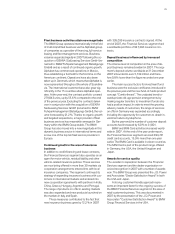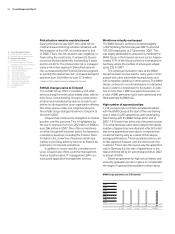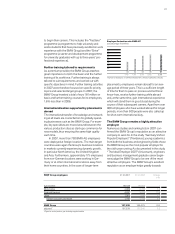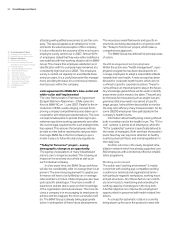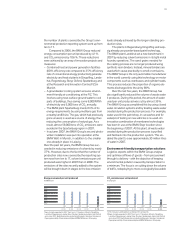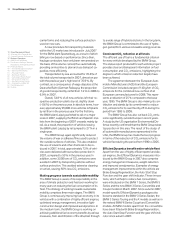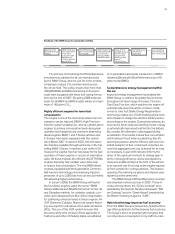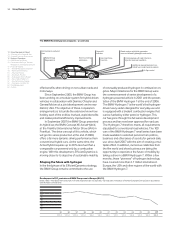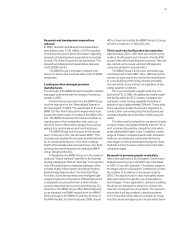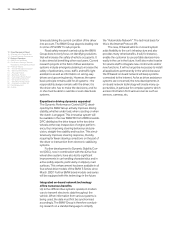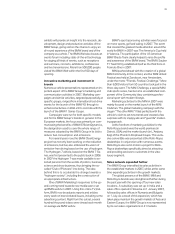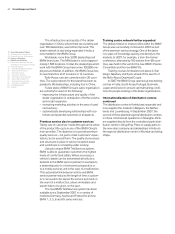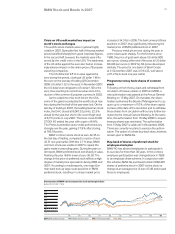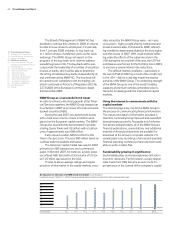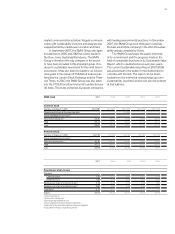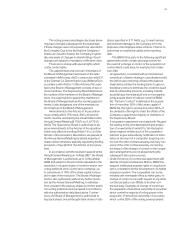BMW 2007 Annual Report Download - page 37
Download and view the complete annual report
Please find page 37 of the 2007 BMW annual report below. You can navigate through the pages in the report by either clicking on the pages listed below, or by using the keyword search tool below to find specific information within the annual report.35
Research and development expenditure
reduced
In 2007, research and development expenditure
amounted to euro 3,144 million, a 2.0 % reduction
on the pre vious year. Further information regarding
research and development expenditure is provided
in Note [11] of the Group financial statements. The
research and development expenditure ratio was
5.6 % (2006: 6.5 %).
The BMW Group’s innovation network com-
prises ten sites in five countries with a total of 9,800
employees.
Leading position amongst premium
manufacturers
The strength of the BMW Group’s innovation network
was again underlined with the receipt of numerous
awards in 2007.
For the third consecutive time, the BMW Group
took the main prize in the International Engine of
the Year Award in 2007. The award went to the new
BMW 3.0-litre Twin Turbo petrol engine which now
powers the entire range of models in the BMW 3 Se-
ries. The BMW Group was the most successful car
manufacturer in this competition and came out
winner in seven of the twelve categories as well as
gaining four second places and two third places.
The BMW Group won the prize for the design
team of the year in the red dot award 2007. This
accolade was awarded for exceptional achievements
for its overall performance in the field of design.
Eight further awards were received for two cars, three
motorcycles and three products created by BMW
Group DesignworksUSA.
In November, the BMW Group won the newly in-
troduced Grüne Lenkrad award from the German
Sunday newspaper Bild am Sonntag in recognition
of its EfficientDynamics measures package, which
includes highly efficient petrol and diesel engines,
Brake Energy Regeneration, the Auto Start Stop
Function, active aerodynamics and intelligent light-
weight construction innovations. EfficientDynamics
is designed to boost performance while simulta-
neously improving fuel economy and reducing CO2
emissions. The BMW Group offers EfficientDynam-
ics as standard in all BMW models from the BMW 1
Series through to the BMW X5 and also in many of
the MINI models. For the model year 2008, around
40 % of new cars sold by the BMW Group in Europe
will emit a maximum of 140 g CO2/km.
Third crash-test facility taken into operation
Approximately 350 to 400 tests are carried out an-
nually at the Research and Innovation Centre (FIZ)
as part of the vehicle development process. Tests are
also carried out to ensure vehicles fulfil legal and
consumer protection requirements.
The BMW Group’s third crash-test facility was
commissioned in mid-2007. Up to 100 tests will be
carried out each year at the new facility near Munich.
In a new building at the facility, all tests (including
roll-over tests) can be carried out regardless of pre-
vailing weather conditions.
The new test facility supplements the one
built
at the FIZ in 2005. An additional, smaller crash-
test facility within the FIZ complex completes the
com pany’s crash-testing capability for testing at
speeds of up to approximately 30 km/h. These addi-
tional capacities enable the Group’s engineers to
conduct time-consuming tests that had previously
only been feasible at the facilities of third-party pro-
viders.
The three crash-test facilities now permit a higher
number of tests and greater flexibility than the all-in-
one solutions favoured by competitors, but which
entail substantially higher costs. In addition, a wide
range of modern computer-based crash simulation
methods are employed, particularly during the
early stages of vehicle development projects. Such
methods cannot, however, replace real crash tests
using prototypes.
Research to promote greater road safety
After a four-year period, the European Commission-
backed research project PreVENT was concluded
in 2007, in line with schedule. The project supports
the target set by the European Commission to halve
the number of accidents on European roads by
2010. The objective was to raise road safety stand-
ards even further through the use of preventative
technologies. These applications, aimed at assisting
the driver, are designed to prevent or at least mini-
mise the consequences of accidents. The research
shows that it will be possible to develop systems
in the future that will be able, for example, to recog-
nise the nature and urgency of a hazard whilst simul-


